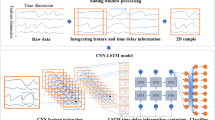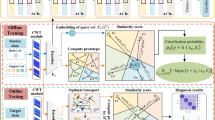Abstract
Purpose
As a critical component of the wind turbine drive train, the bearings are easy to fail under the complex environment of variable working conditions and loads in long-term operation. So it is essential to carry out a study targeting at fault diagnosis on it to improve the safety and reliability of the whole wind turbine operating.
Methods
This paper presents a kind of bearing fault diagnosis method for wind turbines based on convolutional neural network (CNN) and sparrow search algorithm (SSA) optimized extreme learning machine (ELM). First, the wavelet time-frequency diagram (WTD) is constructed by using the continuous wavelet transform (CWT) to the original vibrational signal of the wind turbine bearing. Then, the WTD is input into deep learning CNN for extracting features. Finally, the SSA-ELM classifier is constructed by searching the optimal parameters of ELM with SSA, and the extracted features are put into SSA-ELM to identify different fault types.
Results
The proposed CWT-CNN-SSA- ELM method is experimentally validated by two bearing datasets and compared with other methods. The result shows that the method has better diagnosis capability.
Conclusion
In this paper, a wind turbine bearing fault diagnosis method based on CNN and SSA-ELM is proposed. The approach is able to well extract fault features and classify and identify the bearing data under variable working conditions and time-varying speed with good generalization ability.















Similar content being viewed by others
Data availability statement
The data that support the findings of this study are available from the corresponding author upon reasonable request.
References
Zhang Z, Fan B, Liu Y et al (2021) Rapid warning of wind turbine blade icing based on MIV-tSNE-RNN. J Mech Sci Technol 35(12):5453–5459
Son J, Kang D, Boo D et al (2018) An experimental study on the fault diagnosis of wind turbines through a condition monitoring system. J Mech Sci Technol 32(12):5573–5582
He Y, Ye L, Zhu X et al (2021) Feature extraction based on PSO-FC optimizing KPCA and wear fault identification of planetary gear. J Mech Sci Technol 35(6):2347–2357
Mustafa D, Yicheng Z, Minjie G et al (2022) Motor current based misalignment diagnosis on linear axes with short-time Fourier transform (STFT). Procedia CIRP 106:239–243
Niu Y, Fei J, Li Y et al (2020) A novel fault diagnosis method based on EMD, cyclostationary, SK and TPTSR. J Mech Sci Technol 34(5):1925–1935
Wan S, Zhang X, Dou L (2018) Compound fault diagnosis of bearings using improved fast spectral kurtosis with VMD. J Mech Sci Technol 32(11):5189–5199
Sifuzzaman M, Islam MR, Ali MZ (2009) Application of wavelet transform and its advantages compared to Fourier transform. J Phys Sci 13(1):121–134
Kumar HS, Manjunath SH (2022) Use of empirical mode decomposition and K-nearest neighbour classifier for rolling element bearing fault diagnosis. Mater Today: Proc 52:796–801
Chen X, Yang Y, Cui Z et al (2019) Vibration fault diagnosis of wind turbines based on variational mode decomposition and energy entropy. Energy 174:1100–1109
Wei H, Zhang Q, Shang M et al (2021) Extreme learning Machine-based classifier for fault diagnosis of rotating machinery using a residual network and continuous wavelet transform. Measurement 183:109864
Mansour RF, Escorcia-Gutierrez J, Gamarra M et al (2021) Intelligent video anomaly detection and classification using faster RCNN with deep reinforcement learning model. Image Vis Comput 112:104229
Lomonaco V, Pellegrini L, Rodriguez P et al (2022) Cvpr 2020 continual learning in computer vision competition: approaches, results, current challenges and future directions. Artif Intell 303:103635
Zhao M, Yan W, Luo N et al (2022) An attention-based hybrid deep learning framework integrating brain connectivity and activity of resting-state functional MRI data. Med Image Anal 78:102413
Srikrishna M, Pereira JB, Heckemann RA et al (2021) Deep learning from MRI-derived labels enables automatic brain tissue classification on human brain CT. Neuroimage 244:118606
Li P, Tu S, Xu L (2022) Deep rival penalized competitive learning for low-resolution face recognition. Neural Netw 148:183–193
Hammouche R, Attia A, Akhrouf S et al (2022) Gabor filter bank with deep autoencoder based face recognition system. Expert Syst Appl 197:116743
Zhu Z, Hu Z, Dai W et al (2022) Deep learning for autonomous vehicle and pedestrian interaction safety. Saf Sci 145:105479
Pustokhina IV, Pustokhin DA, Vaiyapuri T et al (2021) An automated deep learning based anomaly detection in pedestrian walkways for vulnerable road users safety. Saf Sci 142:105356
Possemiers A, Lee I (2021) Evaluating deep learned voice compression for use in video games. Expert Syst Appl 181:115180
Lin K, Zhao Y, Kuo JH et al (2022) Toward smarter management and recovery of municipal solid waste: a critical review on deep learning approaches. J Clean Prod 346:130943
Chaiani M, Selouani SA, Boudraa M et al (2022) Voice disorder classification using speech enhancement and deep learning models. Biocybern Biomed Eng 42(2):463–480
Yang T, Zhao L, Li W et al (2021) Towards healthy and cost-effective indoor environment management in smart homes: a deep reinforcement learning approach. Appl Energy 300:117335
Lei Y, Yang B, Jiang X et al (2020) Applications of machine learning to machine fault diagnosis: a review and roadmap. Mech Syst Signal Process 138:106587
Li Z, Liu K, Xiao L (2021) bearing intelligent fault diagnosis under complex working condition based on SK-ES-CNN[C]//2021 global reliability and prognostics and health management (PHM-Nanjing). IEEE, p 1–8
Zhou F, Yang S, Fujita H et al (2020) Deep learning fault diagnosis method based on global optimization GAN for unbalanced data. Knowl-Based Syst 187:104837
Jin Z, He D, Wei Z (2022) Intelligent fault diagnosis of train axle box bearing based on parameter optimization VMD and improved DBN. Eng Appl Artif Intell 110:104713
Xu Z, Li C, Yang Y (2020) Fault diagnosis of rolling bearing of wind turbines based on the variational mode decomposition and deep convolutional neural networks. Appl Soft Comput 95:106515
Chang Y, Chen J, Qu C et al (2020) Intelligent fault diagnosis of wind turbines via a deep learning network using parallel convolution layers with multi-scale kernels. Renew Energy 153:205–213
Zhang K, Tang B, Deng L et al (2021) A fault diagnosis method for wind turbines gearbox based on adaptive loss weighted meta-ResNet under noisy labels. Mech Syst Signal Process 161:107963
Zhang X, Han P, Xu L et al (2020) Research on bearing fault diagnosis of wind turbine gearbox based on 1DCNN-PSO-SVM. IEEE Access 8:192248–192258
Pham MT, Kim JM, Kim CH (2021) 2D CNN-based multi-output diagnosis for compound bearing faults under variable rotational speeds. Machines 9(9):199
Ruan D, Song X, Gühmann C et al (2021) Collaborative optimization of CNN and GAN for bearing fault diagnosis under unbalanced datasets. Lubricants 9(10):105
Chen Z, Gryllias K, Li W (2019) Mechanical fault diagnosis using convolutional neural networks and extreme learning machine. Mech Syst Signal Process 133:106272
Huang G, Huang GB, Song S et al (2015) Trends in extreme learning machines: a review. Neural Netw 61:32–48
Xue J, Shen B (2020) A novel swarm intelligence optimization approach: sparrow search algorithm. Syst Sci Control Eng 8(1):22–34
Tuerxun W, Chang X, Hongyu G et al (2021) Fault diagnosis of wind turbines based on a support vector machine optimized by the sparrow search algorithm. IEEE Access 9:69307–69315
Case Western Reserve University (2019) Case Western Reserve University (CWRU) bearing data center. [Online]. Available: https://csegroups.case.edu/bearingdataceter/pages/download-data-file/
Huang H, Baddour N (2018) Bearing vibration data collected under time-varying rotational speed conditions. Data Brief 21:1745–1749
Lin SL (2021) Intelligent fault diagnosis and forecast of time-varying bearing based on deep learning VMD-DenseNet. Sensors 21(22):7467
Gituku EW, Kimotho JK, Njiri JG (2021) Cross-domain bearing fault diagnosis with refined composite multiscale fuzzy entropy and the self organizing fuzzy classifier. Eng Rep 3(3):e12307
Liu R, Wang F, Yang B et al (2019) Multiscale kernel based residual convolutional neural network for motor fault diagnosis under nonstationary conditions. IEEE Trans Industr Inf 16(6):3797–3806
Wang Y, Ding X, Liu R et al (2021) Conditionsensenet: a deep interpolatory convnet for bearing intelligent diagnosis under variational working conditions. IEEE Trans Ind Inform 18(10):6558–6568
Jiang Y, Zhao H, Niu G (2021) Intelligent rolling bearing fault diagnosis under variable speed conditions without tachometers[C]//2021 global reliability and prognostics and health management (PHM-Nanjing). IEEE, p 1–7
Acknowledgements
This work was supported by the National Natural Science Foundation of China (No. 61803154) and the Natural Science Foundation of Hebei Province(E2019209492).
The authors would like to acknowledge CWRU and the University of Ottawa for providing data sets.
Funding
National Natural Science Foundation of China, 61803154, Yi Zhang, Natural Science Foundation of Hebei Province, E2019209492, Xiaoyue Liu.
Author information
Authors and Affiliations
Corresponding author
Ethics declarations
Conflict of interest
The authors declare that they have no conflict of interest.
Additional information
Publisher's Note
Springer Nature remains neutral with regard to jurisdictional claims in published maps and institutional affiliations.
Rights and permissions
Springer Nature or its licensor (e.g. a society or other partner) holds exclusive rights to this article under a publishing agreement with the author(s) or other rightsholder(s); author self-archiving of the accepted manuscript version of this article is solely governed by the terms of such publishing agreement and applicable law.
About this article
Cite this article
Liu, X., Zhang, Z., Meng, F. et al. Fault Diagnosis of Wind Turbine Bearings Based on CNN and SSA–ELM. J. Vib. Eng. Technol. 11, 3929–3945 (2023). https://doi.org/10.1007/s42417-022-00793-5
Received:
Revised:
Accepted:
Published:
Issue Date:
DOI: https://doi.org/10.1007/s42417-022-00793-5




